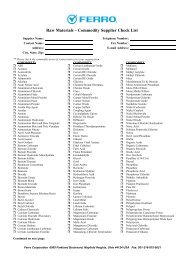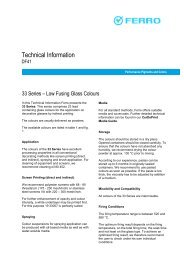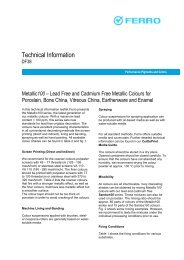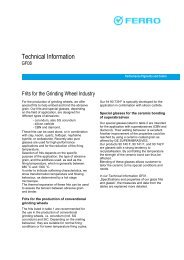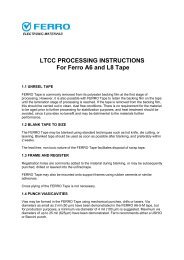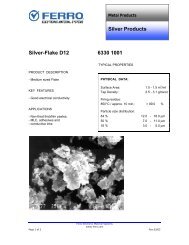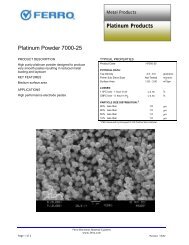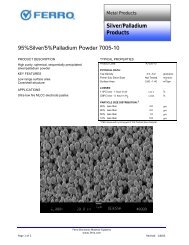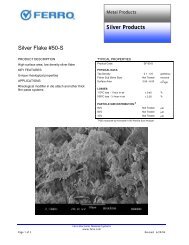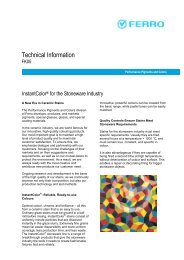Selenium Red and Cadmium Yellow Glazes - Ferro
Selenium Red and Cadmium Yellow Glazes - Ferro
Selenium Red and Cadmium Yellow Glazes - Ferro
You also want an ePaper? Increase the reach of your titles
YUMPU automatically turns print PDFs into web optimized ePapers that Google loves.
Technical Information<br />
GL07<br />
<strong>Selenium</strong> <strong>Red</strong> <strong>and</strong> <strong>Cadmium</strong> <strong>Yellow</strong> <strong>Glazes</strong><br />
Art ceramics cannot be imagined without intense<br />
colours. The brightest red, orange, <strong>and</strong> yellow<br />
colours in combination with brilliant surfaces can<br />
be achieved with cadmium <strong>and</strong> selenium glazes.<br />
<strong>Yellow</strong> <strong>and</strong> red glazes based on the same system<br />
are intermiscible in any relation, thus individual<br />
mixed colours from red via orange to yellow are<br />
obtained.<br />
An addition of 5 to 10 weight-% yellow to the red<br />
glaze is recommended, because the red<br />
becomes more stable <strong>and</strong> brighter. By adding 0.5<br />
to 1.0 weight-% cobalt stain 220 946 to the glazes<br />
43-9361800 or 43-765, intense green colours are<br />
obtained.<br />
Application<br />
Performance Pigments <strong>and</strong> Colors<br />
The selenium red <strong>and</strong> cadmium yellow glazes are<br />
special glasses, whose application properties<br />
cannot be compared to other glazes. Constant<br />
processing conditions are m<strong>and</strong>atory for a<br />
satisfying result. Anti-settling agents <strong>and</strong> glues<br />
can be added, depending on the kind of<br />
application (see also Technical Information<br />
GL11).
page 2/2 GL07 11/12<br />
The glazes should be wet milled in a separate ball<br />
mill, which is only used for Se/Cd glazes, in order<br />
to avoid contamination.<br />
The prepared glaze slip should be sieved <strong>and</strong><br />
processed through a magnetic separator. Also,<br />
only the amount of glaze needed for a few days<br />
should be prepared, because a long shelf-time<br />
can also affect the results.<br />
Contamination of all kinds, especially metal<br />
abrasion from the equipment <strong>and</strong> containers (e.g.<br />
Fe, Cu, Cr, Zn a.s.o.) has to be avoided by all<br />
means, because this might cause black spots on<br />
the glaze surface.<br />
The thermal expansion coefficient of the glazes is<br />
relatively high. We recommend the use of a<br />
special glaze (e.g. 40 134 F) on the inside of the<br />
ceramic piece, to avoid the destruction of the<br />
ceramic due to differences in expansion.<br />
The safest <strong>and</strong> best solution for a perfect result<br />
without cracks or black spots on the glaze<br />
surface is the use of a special body with a high<br />
c.t.e. <strong>and</strong> without pyrite, copper pyrite, or metallic<br />
pieces.<br />
Available products<br />
Firing<br />
PPCDSGL0711/12E<br />
<strong>Ferro</strong> GmbH Performance Pigments <strong>and</strong> Colors Gutleutstr. 215 60327 Frankfurt/M.<br />
Tel. ++49/69/27116-432 Fax ++49/69/27116-243, e-mail: pigments@ferro.com<br />
The result after firing the Cd/Se glazes strongly<br />
depends on the firing time, <strong>and</strong> the kiln<br />
atmosphere. The best is a short firing cycle, a<br />
good air circulation in the kiln, <strong>and</strong> a big space<br />
between the ceramic pieces in the kiln. The kiln<br />
load should be only Cd/Se glazes, because<br />
fumes of other glazes (e.g. copper containing<br />
glazes) might influence the firing result negatively.<br />
Lead <strong>and</strong> <strong>Cadmium</strong><br />
Product no. Surface Colour Temperature<br />
range<br />
If applied properly, the glazes release only a very<br />
limited amount of lead <strong>and</strong> cadmium. But the<br />
release strongly depends on the firing conditions<br />
<strong>and</strong> other parameters, which are difficult to<br />
define. Therefore we cannot guarantee certain<br />
limits that are dem<strong>and</strong>ed by some regulations<br />
(DIN EN 1388.1 <strong>and</strong> 1388.2).<br />
If the glazes are used for food containers, glazed<br />
ceramic pieces out of the production have to be<br />
analysed for lead <strong>and</strong> cadmium release.<br />
Lead<br />
weight-%<br />
C.T.E.<br />
x10 -7 /K<br />
43-765 1 glossy yellow 980 – 1020 °C 0* 82<br />
43-9361800 1 glossy yellow 990 – 1030 °C < 3 80<br />
47-95573 1 glossy red 990 – 1020 °C 0* 76<br />
47-9550900 1 glossy red 990 – 1020 °C < 4 77<br />
1 H phrase 411<br />
*Lead free: PbO



